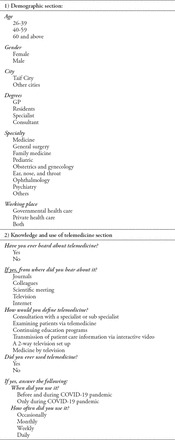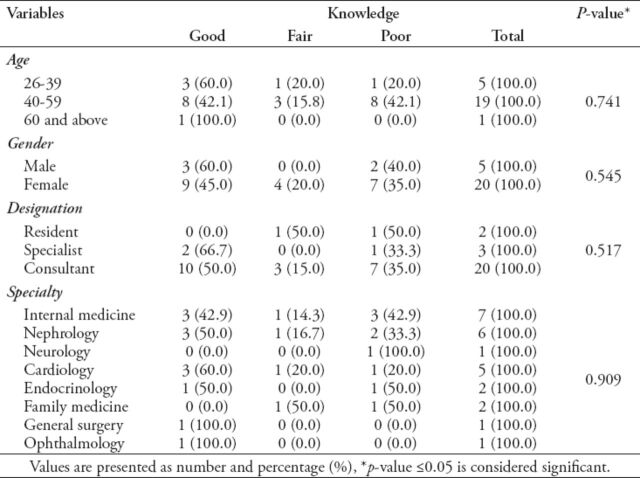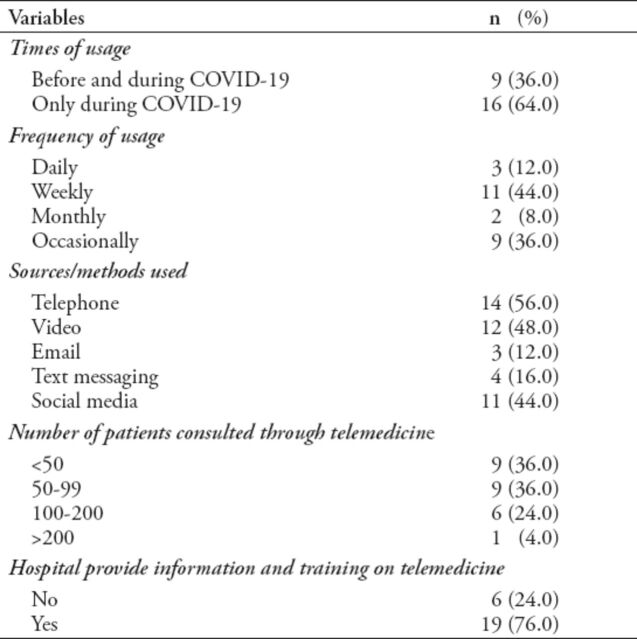Abstract
Objectives:
To evaluate the advantages and disadvantages of telemedicine among physicians during the COVID-19 pandemic. To assess the awareness about telemedicine among physicians and determine their opinions about telemedicine in the post-pandemic era.
Methods:
A cross-sectional study was conducted at government hospitals (King Faisal Medical Complex [KFMC]-King Abdulaziz Specialist Hospital [KASH]) in Taif, Kingdom of Saudi Arabia (KSA), from May-August 2020. Taif is a small city in the western region of KSA with a population of 689,000 and 2 main hospitals (KFMC & KASH) which also serve rural areas close to Taif city. A total of 36 physicians practiced telemedicine, only 25 physicians accepted to participate in this study.
Results:
Thirty-six percent of the responders believed that telemedicine could improve the effectiveness of therapeutic intervention and 44% believed that the quality of care was enhanced using telemedicine. Difficulty in reaching the correct diagnosis due to the lack of physical examination was one of the disadvantages that faced the participants.
Conclusion:
Telemedicine should be part of medical services but should not completely replace physicians’ personal interaction. Telemedicine could be continued for stable remotely residing patients even after the COVID-19 pandemic.
Keywords: telemedicine, COVID-19, doctors, advantages, disadvantages, physicians, pandemic
In January, 2020, the World Health Organization (WHO) declared an infectious disease that was referred to as coronavirus disease 2019 (COVID-19).1 During the ongoing pandemic, the WHO encouraged communities to embrace a non-pharmaceutical intervention, namely, physical distancing.2 The application of telemedicine provides safe, fast, and high-quality care. It can be effectively used to respond to or resolve many new issues. It has been shown to be successful in increasing access to treatment under acute circumstances, such as crises in health care, conflicts, disasters, and remote areas.3,4 To preserve social isolation in response to this crisis and promote health care access, in the United States has gradually increased the use of virtual clinics from 0-97%. Which cover various aspects of patient care to follow up and manage many conditions. There were limitations related to patient confidence in revealing privacy-related issues and how the management would be affected without a complete physical examination and laboratory data.5 In patients suspected to have ataxia, various aspects of the neurological examination can be assessed (namely, eye movements, speech, and coordination).6 The value of telemedicine services for surgical patients is also supported by emerging evidence.7 Also, telemedicine enables physicians to communicate directly with the patient and their relatives and increase the quality of care.8 On the other hand, the principal challenges and barriers facing telemedicine implementation in KSA are consumer acceptance, availability of adequate experts, quality of necessary facilities and infrastructure.9 As a result of the pandemic, the use of telemedicine is required to improve the health care. Few studies conducted in KSA have reported only the barriers that affect telemedicine implementation.9,10 This study intended to illustrate the advantages and disadvantages of telemedicine among physicians during the COVID-19 pandemic in Taif, KSA.
Methods
A cross-sectional study was conducted at government hospitals (King Faisal Medical Complex [KFMC]-King Abdulaziz Specialist Hospital [KASH]) in Taif, KSA, from May-August 2020. Taif is a small city in the western region with a population of 689,000, which also serve rural areas close to it. We used PubMed and google scholar to find similar studies. The sample included all physicians who practiced the telemedicine in Taif, KSA, during the COVID-19 pandemic era. A total of 36 physicians were involved in telemedicine, while only 25 of them accepted to participate. Participants were interviewed by telephone after verbal consent. We included all physicians (consultants, specialists, residents) who used telemedicine during the pandemic in Taif, KSA. Also, we excluded physicians who were not involved in telemedicine, physicians using telemedicine in other cities and physicians who refused to be enrolled in the study. The questionnaire was designed by the authors based upon review of the literature.11,12 It involved 4 main parts: The first part included sociodemographic data such as age, city, degree, and specialty. The second part included questions to assess their knowledge and experience with telemedicine use. The third part evaluated physicians’ opinions on advantages and disadvantages of telemedicine. The last part included direct questions about telemedicine’s future in their opinion and an open question about the suggested medical services to improve the telemedicine system.
This study received approval from the Research Ethics Committee of the Health Affairs in Taif, KSA (IRB: HAP-02-T-067). Statistical analysis was carried out using the Statistical Package for Social Sciences (SPSS) version 23 (IBM Corp., Armonk, NY, USA) by an independent biostatistician. Categorical variables were analyzed using Pearson’s Chi-square test. Continuous variables obtained were expressed as mean and standard deviation. A p-value of <0.05 was considered significant.
Results
Our study was carried out to assess the knowledge, perceptions, and practices regarding telemedicine among physicians working in the public health care settings in Taif, KSA. The survey was sent to all physicians and the final analysis included 25 physicians out of 36 who answered all the items in the questionnaire.
The sociodemographic data of the participants are showed in Table 1 and practices related to telemedicine by physicians in this study are showed in Table 2.
Table 1.
Knowledge regarding telemedicine and its relationship with sociodemographic characteristics.
Table 2.
Practices related to telemedicine by physicians. Note that Table 2 was not mentioned or refereed to in the text please clarify.
The awareness regarding telemedicine among our study population was 60%. The survey had 6 items that measures knowledge related to telemedicine. Each correct response was given a score of ‘one’ and wrong answers were given a score of ‘0’. Thus, the maximum score one could get was 6. The mean total knowledge score in our study was found to be 4.24±1.10 (Min: 0; Max: 6). The total scores were then converted into percentages, which were then categorized into good (>80%), fair (60-79%), and poor (<60%). The results showed that 48% had ‘good’, 16% ‘fair’, and 35% ‘poor’ knowledge regarding telemedicine. The relationship of knowledge and different sociodemographic details showed that there was no statistically significant association seen with age (p=0.741), gender (p=0.545), designation (p=0.517), and specialty (p=0.909) of the physicians (Table 1).
When asked to define telemedicine, 56% described it as choosing to transmit patient information through interactive video and a consultation with a specialist or subspecialist; 48% defined telemedicine as continuing education programs; 24% defined it as examining patients via telemedicine; 12% defined it as a 2-way television set up; the rest 4% defined telemedicine as medicine by television. Approximately 60% heard of telemedicine from a scientific meeting, and 16% heard about it from the internet and their colleagues.
The perceptions related to the advantages and disadvantages of telemedicine, Table 3 showed that 36% of respondents believed that telemedicine could improve the effectiveness of the therapeutic intervention. Approximately 11 (44%) respondents noted that the quality of care was enhanced using telemedicine, and 9 (36%) respondents agreed that telemedicine could help patients to save time and money as one of the advantages. A total of 44% of physicians considered that telemedicine could provide psychological support to patients and improve patients’ compliance compared to clinics (Table 3).
Table 3.
Perceptions of physicians related to advantages and disadvantages of telemedicine.

The percentage of physicians who agreed that telemedicine was inconvenient and time-consuming for physicians was approximately 36% (n=9), whereas 40% disagreed with this. A total of 17 (68%) physicians disagreed that telemedicine resulted in the high cost of hardware and surprisingly no physicians agreed to this in any form. It was observed that 52% (n=13) agreed that telemedicine could cause difficulty in identifying correct diagnosis due to the lack of physical examination. Approximately 40% (n=10) agreed that telemedicine may bring change in the traditional practice of the physicians and 40% (n=10) of them considered that telemedicine might cause issues related to current referral patterns. When we assessed the relationship of perceptions related to advantages and disadvantages of telemedicine with the sociodemographic characteristics, it was found that there were no statistically significant relationships observed with age, gender, degree and specialty of physicians (p<0.05) (Table 3).
Eighty percent of the physicians believed that telemedicine should continue in KSA even after the COVID-19 pandemic and approximately 72% of them agreed that telemedicine offered a better quality of care compared to the face to face clinical consultation.
Discussion
In 2020, due to the COVID-19 pandemic, the usefulness of telemedicine and its ability to deliver high-quality care are becoming more evident worldwide.4
Regarding the advantages of telemedicine, most responders believe that telemedicine can improve the effectiveness of therapeutic intervention, enhance the quality of care, provide psychological support to the patient, improve compliance, and help patients save time, and money. An Indian study in 2020 showed that telemedicine can enhance learning skills, case handling strategies, and help in providing different medical services.3 We believe that the rapid transition to telemedicine in this time of crisis and beyond, offers a new way of accessing our patients, as telemedicine can greatly enhance medical services. It can improve productivity and allows the patients and families to have more time to express their thoughts and feelings, which perhaps is more important now than before the COVID-19 pandemic.13
The main disadvantages telemedicine noted by respondents is that it was difficult to make a diagnosis throughout the virtual clinic due to the lack of physical examination and inability to use their hands-on expertise. Furthermore, the fear of sudden practice changes caused by the COVID-19 pandemic is one of the disadvantages noted by our respondents. This is mostly due to the dramatic shift to virtual clinics owing to the national lockdown and social isolation imposed by the Saudi government during the pandemic. Furthermore, physicians are still not convinced that their patients would use telemedicine technology because the patients are mostly elderly people with limited technological skills. Some patients may not be aware of telemedicine as a choice and do not know how to access it.14
Many physicians in our sample described telemedicine as transmitting patient information through interactive video and as a consultation with a specialist or subspecialist. Other responders chose one of the following definitions of telemedicine, namely, continuing education programs, examining patients through telemedicine, and a 2-way television set-up. We believe in the usefulness of scientific meetings, talking with colleagues, and internet browsing to build a good background about telemedicine basics. Telemedicine is described by the centers for medicare and medicaid services (CMS) as 2-way, live contact between the patient and provider at a distant location, including audio and video devices.5
Our study showed that more than half of the respondents used telemedicine only during the COVID-19 pandemic, and the remaining participants used it before and during the pandemic. We believe that telemedicine adoption was one solution that practitioners used to continue patient care while reducing COVID-19 exposure or transmission. Most of our respondents were consultants, and most of them used telemedicine weekly. The specialists used it occasionally. Half of the resident’s respondents used it monthly. This result was obtained possibly because they had more clinical experience to appropriately analyze patient’s complaints and concerns.
Concerning internet-based technologies, the findings showed that telephone and video were the communication devices used by interviewees, and that they were the preferred resources. The use of video visits in New York, United States, has shown its efficacy, satisfaction in promoting social distancing during the pandemic.15 We believe that video visits typically convey more information than email and other devices. Following the institution COVID-19 pandemic restrictions on in-person clinical encounters, at KASH, a survey was conducted on the number of patients visiting the virtual clinic in one week. At first, the number of remote visits was limited to approximately 75 per week and then considerably increased incredibly to approximately 196 per week within 4 weeks. The reason for the increase in the number of virtual clinics visits in this study was possibly due to the adequate information and training provided to the communities on how the system works, which led to increased telemedicine use.
Our physicians reported that telemedicine should continue after the COVID-19 pandemic as an adjunct tool for the doctors and patients in many ways. The use of this technology is believed to allow improved communication with practitioners and their patients during the pandemic. Over half of our doctors agreed that telemedicine could increase the level of patient care quality. The increase in the use of telemedicine will minimize waiting lists for patients who need in-person interactions during the pandemic.7 This study is affected by several factors like limited virtual clinic numbers in our study area and small sample size. The reason was the national lockdown imposed by the Saudi government during the pandemic, we carried out this study by telephone interviews that lead to difficulty in reaching out to all doctors. The results can not be extrapolated to all physicians in KSA or the western region. Not including patients or caregivers is a limitation too. More sample size and including other cities, patients, and their caregivers are recommended for future research that will give more reliable results. Also, adding important questions to assessing telemedicine satisfaction for both physicians and patients during the pandemic should be included.
In conclusion, telemedicine is a helpful tool during consultations for many medical and surgical conditions, in the psychological field, medical reports, laboratory follow ups, medication refills, and communication with other facilities and other specialties. But, it is not a substitution for the physician’s hands-on expertise.
Acknowledgment
The authors gratefully acknowledge Falcon editing services for English language editing.
Appendix 1 - Telemedicine interview guide. Please note tha the appendix was not metioned in the text please clarify and refer.

Footnotes
References
- 1.World Health Organization. Regional Office for the Western P. The COVID-19 risk communication package for healthcare facilities. Manila (PH): WHO Regional Office for the Western Pacific; 2020. [Google Scholar]
- 2.World Health Organization. Regional Office for the Western P. Role of primary care in the COVID-19 response. Manila (PH): WHO Regional Office for the Western Pacific; 2020. [Google Scholar]
- 3.Singh RP, Javaid M, Kataria R, Tyagi M, Haleem A, Suman R. Significant applications of virtual reality for COVID-19 pandemic. Diabetes Metab Syndr. 2020;14:661–664. doi: 10.1016/j.dsx.2020.05.011. [DOI] [PMC free article] [PubMed] [Google Scholar]
- 4.Latifi R, Doarn CR. Perspective on COVID-19:finally telemedicine at center stage. Telemed J E Health. 2020;26:1106–1109. doi: 10.1089/tmj.2020.0132. [DOI] [PubMed] [Google Scholar]
- 5.Barney A, Buckelew S, Mesheriakova V, Raymond-Flesch M. The COVID-19 pandemic and rapid implementation of adolescent and young adult telemedicine:challenges and opportunities for innovation. J Adolesc Health. 2020;67:164–171. doi: 10.1016/j.jadohealth.2020.05.006. [DOI] [PMC free article] [PubMed] [Google Scholar]
- 6.Manto M, Dupre N, Hadjivassiliou M, Louis ED, Mitoma H, Molinari M, et al. Management of patients with cerebellar ataxia during the COVID-19 pandemic:current concerns and future implications. Cerebellum. 2020;19:562–568. doi: 10.1007/s12311-020-01139-1. [DOI] [PMC free article] [PubMed] [Google Scholar]
- 7.Contreras CM, Metzger GA, Beane JD, Dedhia PH, Ejaz A, Pawlik TM. Telemedicine:patient-provider clinical engagement during the COVID-19 pandemic and beyond. J Gastrointest Surg. 2020;24:1692–1697. doi: 10.1007/s11605-020-04623-5. [DOI] [PMC free article] [PubMed] [Google Scholar]
- 8.Funderskov KF, Boe Danbjørg D, Jess M, Munk L, Olsen Zwisler AD, Dieperink KB. Telemedicine in specialised palliative care:healthcare professionals'and their perspectives on video consultations-A qualitative study. J Clin Nurs. 2019;28:3966–3976. doi: 10.1111/jocn.15004. [DOI] [PubMed] [Google Scholar]
- 9.Alaboudi A, Atkins A, Sharp B, Balkhair A, Alzahrani M, Sunbul T. Barriers and challenges in adopting Saudi telemedicine network:the perceptions of decision makers of healthcare facilities in Saudi Arabia. J Infect Public Health. 2016;9:725–733. doi: 10.1016/j.jiph.2016.09.001. [DOI] [PubMed] [Google Scholar]
- 10.El-Mahalli AA, El-Khafif SH, Al-Qahtani MF. Successes and challenges in the implementation and application of telemedicine in the eastern province of Saudi Arabia. Perspect Health Inf Manag. 2012;9:1–27. [PMC free article] [PubMed] [Google Scholar]
- 11.Whitten P, Franken EA. Telemedicine for patient consultation:factors affecting use by rural primary-care physicians in Kansas. J Telemed Telecare. 1995;1:139–144. doi: 10.1177/1357633X9500100303. [DOI] [PubMed] [Google Scholar]
- 12.Gaggioli A, di Carlo S, Mantovani F, Castelnuovo G, Riva G. A telemedicine survey among Milan doctors. J Telemed Telecare. 2005;11:29–34. doi: 10.1177/1357633X0501100107. [DOI] [PubMed] [Google Scholar]
- 13.Calton B, Abedini N, Fratkin M. Telemedicine in the time of Coronavirus. J Pain Symptom Manage. 2020;60:e12–e14. doi: 10.1016/j.jpainsymman.2020.03.019. [DOI] [PMC free article] [PubMed] [Google Scholar]
- 14.Portnoy J, Waller M, Elliott T. Telemedicine in the era of COVID-19. J Allergy Clin Immunol Pract. 2020;8:1489–1491. doi: 10.1016/j.jaip.2020.03.008. [DOI] [PMC free article] [PubMed] [Google Scholar]
- 15.Mann DM, Chen J, Chunara R, Testa PA, Nov O. COVID-19 transforms health care through telemedicine:evidence from the field. J Am Med Inform Assoc. 2020;27:1132–1135. doi: 10.1093/jamia/ocaa072. [DOI] [PMC free article] [PubMed] [Google Scholar]




